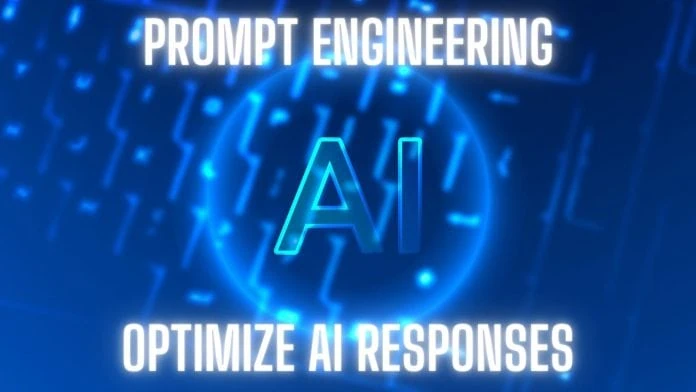Prompt engineering is a vital technique in crafting the commands for our AI companions. Good prompt engineering allows us to feed the AI with better, more accurate information or context. There’s a big difference in response between asking a simple question or providing multiple details to the AI.
Highlights
- Prompt engineering creates specific instructions for AI models to get the right output.
- This job needs practice, an understanding of AI text processing, and creativity.
- Techniques include refining prompts, checking their performance, and adjusting them as needed.
- Research in this field aims to improve how machines understand language.
- Prompt engineers improve our talks with AI, making machine-generated responses better.
What is Prompt Engineering?
In essence, prompt engineering is crafting effective instructions or queries that manipulate AI models, especially large language models (LLMs), behavior, and output.
It emerged with the rise of generative AI tools like text-to-text or text-to-image models, which use prompts to elicit specific responses. Prompt engineering requires refining these prompts to help shape machine-generated outputs in desired ways – a delicate art and science combined.
Today, it has evolved into a six-figure job requiring basic programming skills and an understanding how large AI models interpret and process text.
Definition and core concepts
Prompt engineering is a core discipline in artificial intelligence (AI). It focuses on designing, refining, and optimizing prompts to guide machine learning models effectively.
The aim is to produce accurate outputs using strategically developed high-quality prompts. The creation process employs logic, coding skills, artistic flair, and certain special modifiers for maximum effectiveness.
The diverse nature of the inputs also adds to the broadness of this field, as these can be natural language texts or images. A fundamental principle in this work involves in-context learning, which pertains to a model’s capacity for temporary learning from prompts given at that moment.
Evolution of prompt engineering
Prompt engineering has evolved dramatically, aligned closely with AI tools and natural language processing advancements. From the relative simplicity of early human communication, where prompts were basic words representing ideas, this discipline is now instrumental in enabling communication between humans and complex AI systems.
It shifted from simple word cues to crafting interactions that provide optimal responses from text-to-image or large language models. Nowadays, precise contextual prompts drive effective communications with these AI systems, underlining the critical role of prompt engineers who have mastered this field’s technical and non-technical aspects.
While a relatively recent discipline within artificial intelligence development, prompt engineering continues to thrive due to ongoing research and developments that may unlock future paths for its application.
Techniques in Prompt Engineering
Prompt engineering explores various techniques and methods for refining prompts. The focus is on creating precise instructions or queries to elicit specific responses from our AI models.
Iteration and evaluation form the basis of this process; by constantly tweaking and assessing the prompts it ensures optimal machine-generated outputs. Moreover, we can influence and guide AI behavior following specific needs and scenarios through calibration and fine-tuning.

Creating adequate prompts
With prompt engineering, the aim is to create the best prompts possible for that specific context or problem. These pivotal components guide AI tools to fetch relevant and accurate responses. Here’s are some guidelines on how to create good prompts:
- Initiate with a clear purpose: We always set out with a precise intent while crafting prompts. This ensures that the generated responses align perfectly with our expectations.
- Understand the system behavior: Before developing prompts, we invest time in comprehending how the AI model functions.
- Use human language: To make sure our instructions resonate with AI tools, we articulate them in conventional human language.
- Focus on clarity: Clarity stands at the forefront when generating prompts. Sharper instructions fetch more specific outputs from AI models.
- Keep refining: Prompt creation is not a one-time event; periodic optimization of these questions or commands is necessary for improving language models effectively.
- Evaluate and iterate: We should regularly assess the performance of crafted prompts, iterating as needed to ensure their utility remains optimal.
- Maintain relevance: To guide transformer-based models successfully, ensuring text prompts stay relevant becomes crucial to creating adequate prompts.
Iteration and evaluation
Iteration and evaluation is extremely important in prompt engineering. They are two vital components of this intricate process that turns rough prompts into polished gems.
- Being an iterative process, refining prompts is a task we repeat multiple times. Each repetition presents an opportunity for improvement and enhancement.
- Dedicate significant attention to evaluating the AI model’s responses. This critical step allows us to assess the effectiveness of our current prompts.
- Creating a feedback loop between iteration and evaluation establishes an optimized environment for prompt development.
- Seek out areas for finetuning within each prompt, leading to better interactions with AI systems.
- The culmination of this iterative development proves invaluable in crafting better, more efficient prompts.
The Role of a Prompt Engineer
A prompt engineer must have a firm grasp of technical skills, including basic programming and familiarity with large AI models. They must also excel in non-technical areas like interpreting text meaningfully and understanding context.
These engineers are crucial in refining prompts for AI models, ensuring their outputs are specific, accurate, and fit for purpose. Thus, their work shapes how these models behave and interact, significantly impacting the efficiency of generative AI tools.
Technical skills
As prompt engineers, we need to arm ourselves with various technical skills. These are essential tools that allow us to effectively perform our job and solve complex problems in artificial intelligence and linguistics:
- Machine learning is fundamental in understanding how systems learn and evolve from experience.
- Natural language processing: We use this to help systems understand and interact using human language.
- Data analysis: It allows us to assess the effectiveness of prompts and make necessary improvements.
- Problem-solving: This is crucial for overcoming obstacles in software development.
- User interface design: We need this skill to present prompts to the user effectively.
- Algorithm design: It ensures that our systems carry out instructions efficiently.
Non-technical skills
Non-technical skills play a pivotal role in successful prompt engineering. Here are some key skills:
- Interpersonal skills: Interaction and collaboration with others are vital for generating effective prompts.
- Effective communication: As highlighted earlier, this facilitates clear understanding between team members and stakeholders.
- Mastery of ethics related to AI: Maintaining fairness and avoiding harmful or biased responses stays at the heart of our responsibilities as prompt engineers.
- Expertise in a specific subject area: Extensive domain knowledge helps us create more accurate prompts.
Prompt engineering is paving the way for optimized AI interactions, streamlining how we communicate with these advanced systems. With an acute focus on crafting precise prompts, engineers are shaping the future of our AI-driven society.




